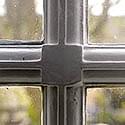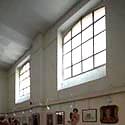
abat–jour, anything that throws light downward, such as a sloping cill [French: ce qui abat le jour].
A word that you won’t see too often, but at least it’s there for when you need it. Our related English word abate means to lower or cast down, and jour meaning light or daylight appears in the English word journey, which reminds us that travel time was originally governed by the hours of daylight. In France it usually means (electric) light shade.
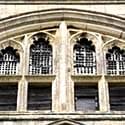
abat–vent, a louvre in the external wall of a bell–tower, protecting against rain while ventilating the belfry and allowing the chimes to be heard.
acanthus, conventionalised representation of the leaf of the Acanthus spinosus plant.
More commonly found in the capital of the Corinthian column, the acanthus motif is used here in a decidedly eccentric manner to enliven a conventional architrave.
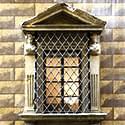
aedicule, an architectural frame around a window, consisting of a cill or pedestal supporting columns, with a pediment or entablature over [Latin: aedicula, a small temple or house].
In the example shown each column is replaced by a ‘term’, a bust or torso on a tapering support (more usually found as a garden ornament).
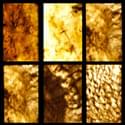
alabaster, a variegated translucent type of gypsum, coloured white, yellow, brown or red, that has traditionally been split into thin slabs for use in windows [the word alabaster is said by some to be from the name of a town in Egypt where it occurred]. See also lapis specularis.
The term is also applied to a pure white variety of a different composition, used in ornaments and portrait busts. Alabaster was in use in windows from early times in Mediterranean countries. The Romans worked mines in Spain, where a highly prized type of translucent gypsum occurred, but these died out after the manufacture of glass was perfected around the first century AD. Alabaster was later much used in Italy in church windows, to great effect.
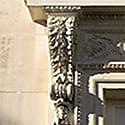
ancon, ancone, a bracket or console either side of a doorway apparently supporting a cornice or pediment; usually, but not always, tapering from top to bottom [Latin: ancon, a supporting stone — but derived from a Greek word meaning ‘elbow’].
Joseph Gwilt’s Encyclopaedia of Architecture, 1888, tells us that in ancient work the ancones were not in contact with the architrave, but situated a small distance from them.
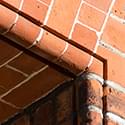
angle bead, a small convex moulding of three–quarter round section at an external angle.
This usually sits in line with the face of the wall and if this is the case is referred to as being double quirked. See also bead, bead–mould.

apron, a raised panel below a window–cill, often with shaped edges or with moulded enrichment [Old French: naperon, a small table–cloth or napkin].
Although the word in its English form has come to mean an article of clothing, there has to be a suspicion that there may be connection between the table–cloth meaning and the Mediterranean habit of hanging rich fabrics out of windows at times of celebration or holy days, the quality of the display indicating the status of the owner.

arcade, the name often given to a long narrow top–lit space.
Architectural historians use this word in its literal sense, ‘a row of arches’. This term came, over time, to be applied to a covered passageway or an arcaded covered walk, especially one with shops or stalls on one or both sides, hence the ‘shopping arcade’. The example shown, in a covered market, incorporates fixed glass louvres to ensure adequate ventilation.

arch, a curved structure over a window opening, usually formed of tapered blocks (voussoirs) acting together to transmit vertical forces to the side supports (springing) of the opening [Latin: arcus, curve, bow, arch, vault].
It seems to be accepted that the Greeks made little use of the arch, restricting it to small structures such as tombs and sewers, and that the Etruscans and the Romans developed the arch form, giving rise eventually to the many and widely differing window–arch variants found in other and later cultures.

architrave, a formalised representation of window jambs with a lintel over the opening, often over–sailing the jambs to form projections known as ‘ears’. A cyma recta moulding usually follows the outer edge of jambs and lintel, and occasionally the cill [ARCH, chief or principal + Latin: trabs, a beam, tree trunk, rafter].
In many examples the original function of the projecting lintel is ignored and the height of the ‘ears’ bears no relation to the height of the lintel, even — in extreme cases — taking on an anthropomorphic character. See also shouldered architrave and lugged architrave.
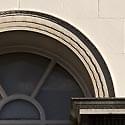
archivolt, the mouldings applied to an arch, usually matching the architrave if one exists.
In this example the archivolt matches the architrave component of the entablature.
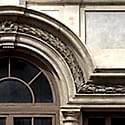
arcuated entablature, a peculiar form of entablature that takes the form of an arch over part of its length.
The illustration shows an arcuated entablature over a type of Vitruvian window, also known as a Serliana.
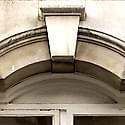
arcuated lintel, a lintel incorporating an arch, either semi–circular, segmental or in the form of a basket–handle arch.
It is not unusual to find a keystone incorporated, on the model of a true arch; but as the forces in a lintel (compression at the top and tension at the bottom) bear no resemblance the forces in an arch proper (all members in compression) the result is structurally impure. At best it can only be seen as a pair of oddly–shaped cantilevers separated by a keystone–shaped block apparently tending to push the cantilevers horizontally, in other words a form of Welsh arch.
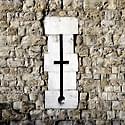
arrow–loop, also known as a loop–window or loop–hole; a vertical slit in the wall of a fortified building for purposes of defence [Dutch: gluipen, narrow opening, a crack in a door].
Due to the thickness of most defensible walls the narrow slit opened out internally to improve the horizontal line of fire, and this was sometimes augmented by the introduction of a horizontal slit or slits to improve visibility. After the introduction of gunpowder the ends of the slits were sometimes enlarged to form holes that would enable firearms to be used.
art–deco, a style that replaced the tendril–like sinuous curves of art–nouveau with severe geometric shapes and motifs.
art–nouveau, a style characterised by flowing forms and asymmetry, once deemed emblematic of youthfulness, but ultimately worked out and now considered somewhat decadent.
arts–and–crafts, a working philosophy embodying notions of excellence in craftsmanship, simplicity, truth to materials, and functionality.

astragal, a small convex moulding; in Scotland, a glazing bar (of any variety or pattern) [Latin: astragalus, a haunch bone — from which is derived the meaning ‘convex shape’].
The translation from Latin is sometimes given as ankle bone, which is more descriptive of its commoner sense — ‘small convex shape’, as in the small rounded moulding immediately below the capital of a column. As it increases in size the astragal becomes a torus. See also under mouldings.



